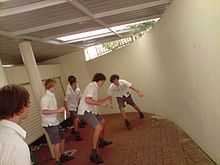Wallball


Wallball is a type of school yard game similar to butts up, aces-kings-queens, American handball and Chinese handball. The sport was played by a few schools in the San Francisco Bay Area and New York City, then began gaining much popularity, resulting in a popular world wide sport. Wallball is now played globally with the international federation, Wall Ball International, promoting the game.[1] The game requires the ball to be hit to the floor before hitting the wall, but in other respects is similar to squash. It can be played as a singles, doubles or elimination game.
Wallball is derived from many New York City street games played by young people, often involving the Spalding hi-bounce balls created in 1949.
Objective
The objective of wallball is to eliminate all other players in order to be the last player standing, or to be the starter of the game continuously (if the game is endless).
Rules
People first decide who serves. This procedure varies, but is usually the winner of the previous game or the person who got the ball (if that would be the first game). The server first hits the ball forward and down so that it hits the ground and bounces up to hit the wall. If it bounces on the ground more than once or if it doesn't bounce on the ground before in hits the wall, it is considered out. Then, after hitting the ball, the ball would bounce back, and the next person would do the same thing. If the ball bounces more than once before the second player hits it the second person is out, but hitting the ball before in bounces is allowed after the first person hits the ball. If the ball bounces out of bounds (the boundaries are usually determined by the orange lines surrounding the field) at any time, it is considered out, and if it hits the orange line, it is sometimes considered in, sometimes considered out, and sometimes considered a "liney", in which the game stops and the person who made the liney serves again. The goal is to get the person behind you out by hitting it with the right force and in the right direction. There are sometimes rules called "first serves", in which the server doesn't get out until the third time the server gets out. There are many variations to the rules, but the rules above are the classic ones. Babies, in which the ball on the second bounce is smaller than the closest interior orange line to the wall (there are two orange lines; one is about three-four feet from the wall, and the other one is about two-thirds of the court away from the wall) and sliceys (or skimmers), where the ball goes at an extremely high speed and extremely low height, are very common varying things (in or out). There are four main types of wallball: regular, teams, line-up, and random. Regular is where the players line up outside of the court on a bench (which is usually present) or standing if there is no bench, and two players enter the court. They play, and the losing player goes to the end of the line, and the next person comes up. Teams is the same as regular, except that there are four (or more, but even) players that come up (grouped in equal teams). Line-up is where all the players line up in a line that is either determined by the winning person or in "random order", where the players pick the order, and they play in order (the server goes after the last person). Random is where all the players are scattered around the court, the server serves, and a random person (whoever wants to hit the ball) comes up and hits the ball. In random, when nobody hits the ball, players determine who is out by either considering it a re-do (the server or another person serves again), "flinching" (the person who reacts to the ball in a fashion that looks like the player is going to hit the ball), nearest person (the closest person to the ball is out), or a combination of nearest person and flinching (if somebody flinches, the flinching person is out; if nobody flinches, the nearest person is out). In line-up or random, the winner of each game usually decides the rules and game style of the next game (usually with the classic rules, but the winner usually has the right to change them, though if enough people disagree, the idea is usually not used), and in regular or teams, the first person to beat the whole line gets to determine the rules and game style of the next game. If playing with a soccer/Football they have to hit it wherever it lies if against a fence rock or even round the wall, the player whose turn it is has to bounce it off an object but if another person hits it after someone hits the ball their opponent wins.
Alternative rules
Players stand a few feet away from the wall. They may only get three outs (no outs if you want the game to be endless). A player servers the ball by throwing directly at the wall. The ball then should return to another player. It is not an out if you get the ball again but is considered unfair if you intended to get the ball back (however, if the ball returns to you three times, it is formally known as a "tea party", and you are out). If the ball bounces first, it is an out. If you drop the ball or the ball hits you, you will have to get to the wall before someone else throws the ball and hits the wall or you will get an out. If you get the ball that is out-of-bounds, players are permitted to shout "challenge!" During challenges, you have to throw the ball from the same place where you picked up the ball. You may only take tiny steps then throw or move backwards. If you move anywhere else, you will get an out. These alternative rules are more common in the Midwest and Canada. In Australia however the rules are slightly different where there are rules for spiking. Spiking is when the ball hits another player on the full without bouncing and the player which is hit goes on the wall.
Wallball language
- Baby – a small, hard to get shot (ball must clear two feet from the bottom of the wall)
- Bad Serve – an incorrect serve
- Black Magic – placing one's hands in front of the ball, but not hitting it, when opponent's turn
- Crossy – a shot played across the wall to make the opposition run for the ball (sometimes called cross country)
- Double Bounce – ball bounces more than once before hitting the wall (this is out)
- Drop Shot – hitting the ball with an angle that makes the ball skim the wall (sometimes called waterfall)
- High Wire – a big hit
- Holdy – when someone holds on to the ball rather than slapping/hitting it (holds is out)
- (Hyper) Skimmer – a low, fast-moving ball, a hyper, or super, skimmer goes exceedingly fast and low, and can only be performed by talented players (may be known as something else, like slicey or snake)
- Interference – when the ball hits an outside object or hits a player directly after being hit by another player (before hitting the wall)
- On the full – hits the wall on the full (this is out)
- Rainbow – Player can call "Rainbow" and must go under the ball without touching the ball successfully (sometimes called underdogs)
- Shotgun – a hard hit that directly hits the wall, rather than bouncing once; typically followed by the elimination of the player who shot that ball (may be known as something else, such as bullet)
- Skid – The ball returns in a faster pace due to wet contact.
- Time Out – stopping the game right in the middle of it (Player must call Time in to play again)
- Traps – where the ball hits directly on the join between the wall and ground (this can be played on or replayed) (also known as "Pops", "Gutter" or "Poppy's")
- Trap bounce – where the ball traps after bouncing once (this is out)
- Type Writer – hitting the ball at the wall, then continually hitting the ball without it touching the floor until the hitter sees fit to let the ball rotate to the next player by hitting the ball against the wall one last time with force. Type Writer should not exceed 5 seconds.
- Overdog – jumping over the ball instead of hitting it
See also
- Four Square
- American Handball
- Butts Up
References
- ↑ "Wall Ball International Webpage". Retrieved 1 October 2013.